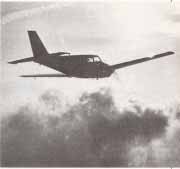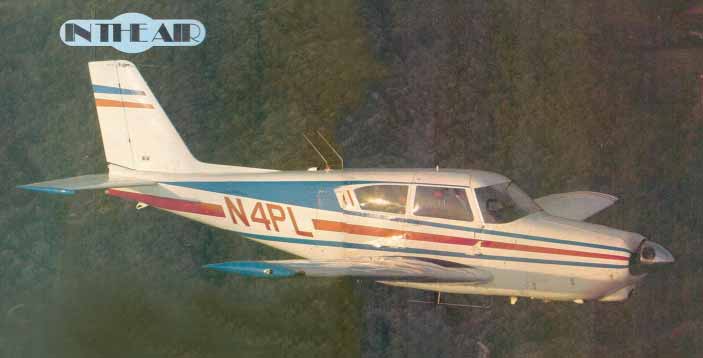The year was 1956. Elvis Presley was just leaving the
Yellow Sun label in favor of RCA Victor, Ford was halfway through their
classic run of Thunderbirds and, for nearly ten years, the Beech Bonanza
had been king of the singles. Pug Piper didn't like that. As far as
that goes, nobody at Piper did. But it was Pug who decided it was time
to build a Bonanza killer or, at the very least, an airplane that could
run alongside it on a lot less horsepower. Up to that point Piper had
never totally designed an all-metal airplane, the Tri-Pacer was still
their standard bearer, and the sweet potato-like Apache had started out
as a Stinson. Piper's reputation then, as now, was that of a company
which built conservative, easy-to handle airplanes which got you where
you were going but weren't known for their racy tailoring. Pug wanted
to break the mold with a new design.
Assembling a team of Piper engineers, with Pug at the helm, Piper began
to sift through the then-available NASA reports on laminar flow, stabilators,
drag reduction, and many of the other go-fast concepts which
had their roots in the technological advances of World War Two. Reportedly
they even went so far as to evaluate the prototype Mooney Mark 20, but
found its dwarf-like cabin dimensions and wooden wings to be out of character
for the design they had in mind.
By 1957 the new design, which was christened the "Comanche," had
sucked up its retractable gear and was an airborne idea. At that time
Piper Aircraft was only a little over twenty years old and it was obvious
that the Comanche was by far the best-looking airplane that Pi-per had
ever built. Now, twenty-five years later, the same thing could be said
all over again: the Comanche is, without a doubt, the best-looking airplane
Piper ever designed.
In production for nearly thirteen years in a number of variations,
the Piper Comanche has become a tool of sophisticated single-engine
airplanes available for a reasonable dollar that gives
at least adequate performance with more than adequate accommodations.
As originally produced with its 180 hp, the airplane has earned a
less-than-enviable reputation as a two-place craft that had a back
seat. However, as Jack Cox, the EAA editor of Sport Aviation puts
it, "You just have to be a little patient with it." Such
could be said for any four-place airplane with a smaller engine.
 |
A 250 Comanche was my first
flying job for a small real estate company when still in college.
Took it into some amazingly small strips...I was too young to
know better. |
The 250 and 260 hp Comanches did exactly what they were supposed to
do: they let you run up alongside a Bonanza, but not for very long
because, try as they may, Pug's boys weren't quite able to come up
with a Bonanza killer on the same horsepower. That v-tailed
crow-bar from Wichita always seemed to have five or six miles per hour
on the Lockhaven speedster. The next logical step would have been a
285, like the Bonanzas were using, but Piper has always been Lycoming
oriented so that change would have meant switching brands. So they
took the next, not-so-logical, step and went to the 400-horse eight
cylinder Lycoming that suddenly made the Comanche into a regular fighter,
providing you could get it started (something which wasn't always a
fact). The 400 Comanche would get out and boogy around 210 mph, at
which point it truly was a Bonanza killer. Of course nobody to this
day knows how fast a Bonanza would go with the same engine, but logic
would dictate that it would be at least a little bit faster.
WHEN YOU GO TO BUY A USED BONANZA YOU'D better listen closely to the
tales about this or that model being the best; watch for such-and-such
an AD and such-and-such a modification. Not so with the Pennsylvania
Indian. Although the Comanche does have a number of ADs, it has often
been said that if the Comanche had been built in Wichita most of those
ADs would have been service letters, because they are usually of such
a minor nature. It's a Piper and, as with most Pipers (repeat: most,
not all), there are none of the do-not-get-close-until-fixed type of
ADs that grounded the entire fleet. It's little stuff—when you
go look at it, if it's broken you fix; if not, you don't—things
like putting in a doubler on the inboard end of the ailerons
where the actuating horn attaches, or taking a close look at the thin
attach points or the two bolts going through the stabilator attach
(they should be changed to stainless). Also ninety percent of the ADs
pertaining to Comanches are so old that there are very few, if any,
of the airplanes flying that haven't had most of them complied with
by now.
The landing gear is one area that does require a certain
amount of inspection before buying it, particularly to see that it
has been well maintained. The bushings and rod ends on a Comanche gear
tend to take a relatively healthy beating, probably because
they're so close to the dirt and, if they are not properly cleaned
and greased, you may someday find yourself sliding in on your elbows.
What
the airplane lacks in Bonanza-like speed it more than makes up for
in Bonanza-like comfort. You'd have to be in the 6 ft 5 in category
before you'd find yourself running out of leg and/or head room in
the Comanche, although the seating position is not nearly as bolt
up-right as that on a Bonanza. Also, the seat position is such that
a good-sized front-seat passenger can slide his seat back and not
amputate the legs of the folks in the back seat.
Back in the sixties, when the Bonanza and the Bellanca were
the only other retractable-gear singles around in any number, the Comanche
represented the logical first step into a high-performance airplane,
and the checkout for a neophyte pilot often served as a rite of passage
into the world of real airplanes. Like as not, the transitioning pilot
was taken up to 8 or 9,000 ft, where he was told it was safe to do
a stall series, "in case it got away from him he'd have plenty
of room"--a ridiculous precaution in light of the fact that the
airplane's stalls are relatively innocuous and more or less straightforward,
considering the performance potential. However, the instructors
of the time had been working with Tri-Pacers, so the Comanche loomed
as a P-51 in their minds. At the same time, however, it was fairly
commonplace for 120-hour pilots to be turned loose with a Comanche
after only three hours of dual, something which indicates the airplane's
basic docility and ease of handling.
GO TO NEXT PAGE
|

